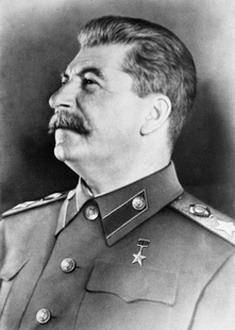Biography of Joseph Vissarionovich Stalin
Explanation:
Joseph Vissarionovich Dzhugashvili (Stalin) was born on December 21, 1879 in the city of Gori (Georgia), in the family of a cobbler. In 1888 J. Dzhugashvili entered a religious school and in 1894 graduated with distinction, entered a theological seminary in Tiflis. It was here that he was first introduced to the main ideas of Marxism. Dzhugashvili joined the Georgian Social Democratic Party "Mesame-Dasi" in 1898, and in 1899 he was expelled from the seminary for being involved in Marxist underground circles. From that moment on, the story of a professional underground revolutionary, an audacious expropriator, began. He had many pseudonyms, such as Riaboi, Vasili, and Vasiliev. Of these, however, two have gone down in history - Koba and Stalin.
Between 1902 and 1913 Dzhugashvili was arrested and exiled six times. He made several audacious escapes from prison. From 1907, Dzhugashvili led the activity of the Central Committee of the RSDLP in Baku and shared the ideas of Lenin, at the suggestion of whom in 1912. Stalin was included in the RSDLP Politburo. Until Lenin's return from Switzerland in April 1917. Stalin led the Russian revolutionary movement. In 1917 he became a member of the editorial board of Pravda newspaper and actively participated in the preparation of its first issue. After the Bolshevik seizure of power in October 1917 up to 1922 Stalin held the post of People's Commissar for Nationalities. In 1922 he was elected General Secretary of the Central Committee of the CPSU(b). Stalin proposed the concept of a Soviet Union in which he gave the leading role to a strong RSFSR. In the late 20s he criticised the NEP, suggesting a transition to forced industrialisation.
Because of serious political differences and a reluctance to accept criticism of his course by major Russian politicians, Stalin pursued a policy of repression against old revolutionaries, the intelligentsia and their families in the 1930s. The repression, to which the command staff of our army was also subjected, considerably weakened the defence capacity of the USSR. A system of camps was created in which prison labour was used in the construction of many industrial and infrastructure facilities.
Between 1928 and 1940, three five-year plans for the development of the country's economy were implemented under Stalin's leadership. By 1941, a new industrial base was established in the Urals and Siberia, which was the key to the Soviet victory in the Great Patriotic War.
In international relations, after the Nazis came to power, Stalin drastically changed the traditional Soviet policy: whereas previously it had been aimed at an alliance with Germany against the Versailles system, it now consisted in creating a system of "collective security", consisting of the USSR and the former Entente countries against Germany. However, France and Britain feared the USSR and hoped to 'appease' Hitler (the 'Munich deal'). By 1939, the international situation had deteriorated sharply due to German claims against Poland. This time, England and France were ready to enter into war with Germany, trying to draw the Soviet Union into the alliance. In the summer of 1939, Stalin supported negotiations for an alliance with England and France, but at the same time he started negotiations with Germany (Non-Aggression Pact of August 23, 1939). On September 1, 1939, World War II began, and on June 22, 1941, the Great Patriotic War.
When the war began, Stalin was the Chairman of the State Committee of Defense, People's Commissar of Defense and Supreme Commander of the Armed Forces of the USSR. After the war, the Council of Ministers of the USSR and the Central Committee of the CPSU (b) under Stalin's leadership set a course for rapid reconstruction of the economy which was destroyed by the war. Stalin retained the post of Chairman of the Council of Ministers of the USSR until his death. Stalin died on 5 March 1953.
